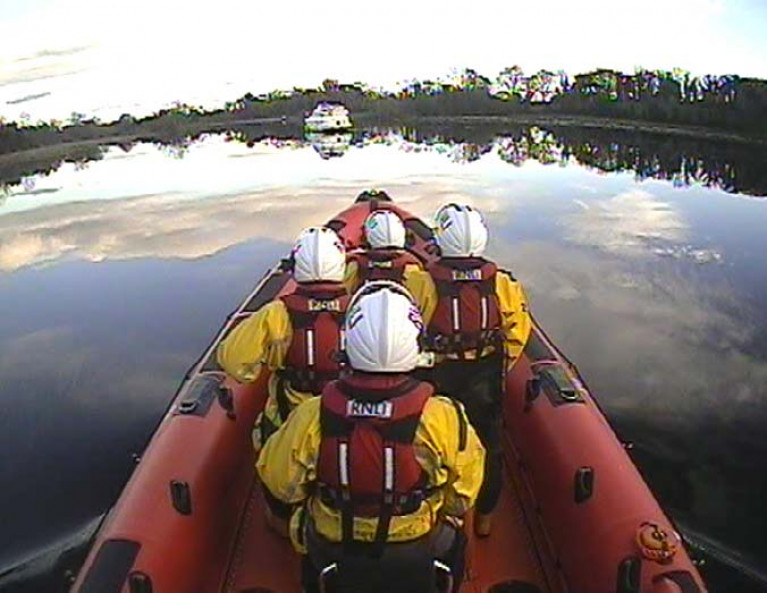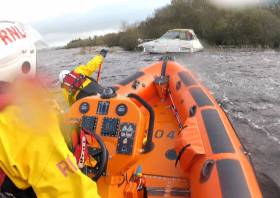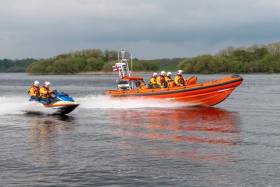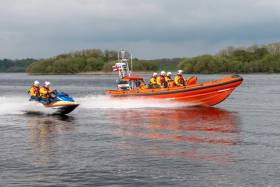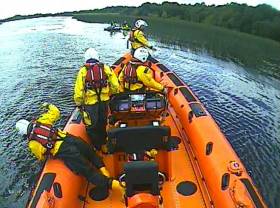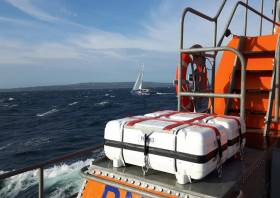Displaying items by tag: Carrybridge
Carrybridge RNLI Assist One Person on Motor Cruiser Aground
At 4.17pm on Wednesday 4 March, Carrybridge RNLI’s inshore lifeboat, Douglas Euan & Kay Richards, and Rescue Water Craft (RWC) was launched to a vessel with one person on board which had run aground approx. 2 miles North of Carrybridge.
Winds were North West, Force 1. Visibility was good with clear conditions.
The lifeboat and RWC arrived with the casualty vessel which had run aground due to the high-water levels at present. The volunteer crew checked the wellbeing of the passenger on the casualty boat and the vessel itself and found all was were ok.
With the owner’s permission, a tow was established with the casualty vessel and it was refloated into deeper water. The craft was checked for damage and all was found to be in order. The vessel with its one person onboard was able to continue on its onward journey.
Speaking following the call out, Chris Cathcart, Volunteer Lifeboat Press Officer at Carrybridge RNLI advised all boat users: ‘‘At this time of year when the water levels are higher than normal, it is especially important before setting out to plan your journey, have the relevant charts required, lifejackets for all on board and a means of calling for assistance if you find yourself in trouble. If you see someone in trouble on the water or are in difficulties yourself the number to dial is: 999 or 112 and ask for the Coastguard.’’
Two volunteer crew members at Carrybridge RNLI lifeboat station have had a vital part of their crew training funded by Lloyd’s Register Foundation.
Shani Spence from Lisbellaw and Joe Donnelly from Enniskillen, recently travelled to the RNLI College in Poole, Dorset, to complete the charity’s Crew Emergency Procedures course.
The course sees volunteer crew being trained in a variety of crucial subjects such as how to deal with fires aboard lifeboats, how to ‘abandon ship’ in the event of an emergency (with a 4m jump into water), team survival swimming, coping in a life-raft in simulated darkness, how to right a capsized inshore lifeboat, and the importance of lifejackets. It also includes sessions on the correct use of flares, fire extinguishers and throw bags.
Talking about the training, Shani, who volunteers as a crew member, said: ‘This course definitely helped with my confidence in an actual emergency as I got to have a hands-on approach and see how it all feels in real life, meaning it will be a little less scary if anything went wrong.’ Joe, who also volunteers as a crew member, said: ‘It was a very good and intriguing course which I enjoyed very much.’
Shani and Joe’s training took place in the Sea Survival Centre at the RNLI College, where they were joined by other RNLI volunteer crew members from around the UK and Ireland.
The training was funded by Lloyd’s Register Foundation, a charitable foundation that helps to protect life and property by supporting engineering-related education, public engagement and the application of research. The Foundation has committed to funding the RNLI’s Crew Emergency Procedures course for a second 5-year period until December 2020. This additional funding of £1.06M brings their total support for RNLI crew training to just over £2.46M* since 2008. More than 3,000 RNLI volunteer crew members have now received the training thanks to Lloyd’s Register Foundation’s funding.
Alex Evans, Lifesaving Training Manager at the RNLI said, ‘We are so grateful to Lloyd’s Register Foundation for funding this vital part of our volunteer crews’ training.
‘Their support is very important to us and it’s fantastic how, so far, over 3,000 of our crew members have benefitted from Lloyd’s Register Foundation funding this part of their training. As only one in ten of our volunteer crew members comes from a professional maritime background, the Crew Emergency Procedures course is crucial in giving our volunteers the training they need and helping keep them as safe as possible while carrying out rescues. It gives volunteers the confidence to save lives even in the most challenging conditions.’
This donation is the latest in Lloyd’s Register Foundation’s relationship with the RNLI, which was recognised in 2010 when it received the Group Supporter Award from HRH Prince Michael of Kent in recognition of its valuable support of the charity.
Carrybridge Lifeboat Assists Vessel Adrift Near Island In Upper Lough Erne
Carrybridge RNLI’s inshore lifeboat launched yesterday afternoon (Tuesday 12 November) to a vessel adrift close to an island in Upper Lough Erne north-east of Knockninny Marina.
Winds were north-westerly Force 2 when the lifeboat Douglas Euan & Kay Richards arrived on the scene and slowly proceeded to the location of the vessel, with one man on board.
With the owner’s permission, and due to weather conditions pushing the boat onto the island, the lifeboat crew set up a tow line to being the casualty vessel into deeper water and then onwards to the safety of the marina.
Speaking following the callout, lifeboat operations manager Stephen Scott advised all boat users: “Before setting out on your journey, please plan your route and carry out regular checks of their vessels.
“With the constantly changing water levels at this time of year, please be vigilant for floating debris in the water. Also have a means of calling for assistance if you find yourself in trouble.
“If you see someone in trouble on the water or are in difficulties yourself the number to dial is: 999 or 112 and ask for the coastguard.”
Carrybridge RNLI is currently seeking new crew members to join its search and rescue service in Co Fermanagh, and will be hosting an open evening for all interested candidates at the lifeboat station next Thursday 21 November from 7pm.
Carrybridge RNLI Seeks New Lifeboat Volunteers For Lough Erne
Carrybridge RNLI is looking for new volunteer crew members to join its search and rescue service on Lough Erne.
The station, on the River Erne between the upper and lower loughs, is now calling on potential recruits to come forward and learn how they can get involved in helping the charity continue to save lives at sea and on inland waterways.
Later this month, on Thursday 21 November from 7pm, the lifeboat station will be hosting an open evening for all interested candidates to learn more.
Originally part of Enniskillen RNLI, Carrybridge RNLI was established in 2002 due to the increase in pleasure boating activity on Lough Erne.
In October 2015, a new station was officially opened and a larger Atlantic 85 lifeboat was placed on service in November 2017, to replace the older Atlantic 75 and to join the existing rescue water craft (RWC).
To date the lifeboat, Douglas Euan and Kay Richards, and RWC have launched 41 times on service in addition to weekly training exercises.
Stephen Scott, Carrybridge RNLI lifeboat operations manager, is now calling on any potential volunteers to come along to the open evening and find out more.
“We are looking for anyone aged 17 years and over who is willing to offer some of their free time to join what I believe to be one of the most exhilarating and rewarding voluntary services that is out there,” he said.
“While experience on the water is helpful, every volunteer receives first-class training from the RNLI and learns new skills which can benefit them in many walks of life. Lifeboat crew members need to have a reasonable level of fitness.”
Anyone who feels they have the time and commitment to volunteer for the charity which is on call 24 hours a day, 365 days a year, is asked to email Stephen at [email protected]
Carrybridge Lifeboats Launch To Help Two On Broken Down Vessel
Carrybridge RNLI's inshore lifeboat and rescue water craft (RWC) were launched last night (Monday 7 October) after 7pm to a vessel with two people on board which had suffered engine failure around half a mile upstream from the Killyhevlin jetty.
When the lifeboat Douglas Euan & Kay Richards and RWC arrived on scene, they proceeded slowly to the vessel's location close to the reed line.
Once the boat's condition was assessed, and with the owner's permission, the volunteer lifeboat crew set up a tow and brought the casualty vessel in to deeper water, and then onwards to Killyhevlin jetty.
Speaking after the callout, Chris Cathcart, helm at Carrybridge RNLI, advised all boat users to take proper care when plotting their trips on the water.
"Before setting out on your journey please plan your route and carry out regular checks of their vessels. Also have a means of calling for assistance if you find yourself in trouble. If you see someone in trouble on the water or are in difficulties yourself the number to dial is 999 or 112 and ask for the coastguard."
Carrybridge RNLI Exercise with Passenger Vessel, Inishcruiser
On Thursday 19 September, Carrybridge RNLI’s inshore lifeboat, Douglas Euan & Kay Richards held a towing, casualty care and mass evacuation exercise with the passenger vessel from Share Discovery Village, Inishcruiser. The exercise took place close to the Share Centre.
The weather couldn’t have been better with flat calm conditions.
When the lifeboat first arrived a tow was established for the volunteer crew to practise moving a boat as big. A side by side tow, a tow where the lifeboat is tied alongside another boat, was set up so the crew could then try turning the vessel. The much smaller lifeboat was able to complete this with ease.
The lifeboat and its crew then moved away from the Inishcruiser and waited until called for the next part of the exercise, casualty care. Already on the Inishcruiser were three volunteer crew who along with three crew from the lifeboat found a lady in a wheelchair that needed assistance but also a man, face down, with chest pain. Casualty care was administered to both casualties with the man who had a suspected heart attack being treated using the equipment carried by the lifeboat.
During this time the staff from Share along with lifeboat crew who had been acting as passengers, evacuated the passenger boat into two waiting boats which made several runs back to the centre. The lady in the wheelchair was lifted from her chair into the boat followed by the man with the chest pain who was transported back to the land in the lifeboat.
Speaking following the exercise, Stephen Scott, Lifeboat Operations Manager at Carrybridge RNLI said: ‘‘We would like to thank the staff from Share Discovery Village for helping to arrange this very valuable exercise. It gave our crew a great opportunity to work with a bigger vessel as well as working with a large amount of people including the two casualties who played the part extremely well. We would also like to remind everyone that if you see someone in trouble on the water or are in difficulties yourself the number to dial is: 999 or 112 and ask for the Coastguard.’’
Busy Weekend For Northern Ireland Lifeboats As Summer Season Ends
Northern Ireland lifeboat crews marked the end of the summer season with a number of callouts over the weekend.
On Saturday afternoon (31 August) Portaferry’s inshore lifeboat wad called out to reports that two Flying Fifteen keelboats had capsized on Strangford Lough.
On arrival it was found both vessels had been righted and were returning to shore, Portaferry RNLI said.
But while out on the lough, the lifeboat crew were also tasked to aid a 36ft yacht which had run aground on Don O’Neill Island some four miles away.
At the scene, the lifeboat crew ensured that all on the yacht and their dog were safety aboard their vessel and that there was no water being taken on.
The following afternoon (Sunday 1 September), the inshore lifeboat launched to a motorboat with two adults and three children that had run aground in the Narrows.
Another vessel had taken the casualty boat under tow to deeper water and the lifeboat crew followed up by escorting the motorboat to Portaferry Marina.
Elsewhere on Sunday, Carrybridge RNLI’s inshore lifeboat and rescue water craft were launched to a vessel with four on board which had grounded west of the Share Centre on Upper Lough Erne.
After carefully navigating the shallow waters and assessing the condition of the two adults and two children on board, the lifeboat crew checked the vessel for water ingress and none was found.
With the owner’s permission, the volunteer crew set up a tow line and proceeded to refloat the casualty vessel in deeper water.
The barge was again checked for water ingress and the steering and propulsion also checked before they were allowed to continue their journey.
Carrybridge lifeboat operations manager Stephen Scott reminded all boaters to plan their routes carefully using revenant charts to avoid difficulties in unexpectedly shallow waters.
Kilkeel Lifeboat Races To Speedboat Breakdown In Carlingford Lough Busy With Shipping
Kilkeel’s volunteer lifeboat crew worked fast to help clear a speedboat with engine troubles from a busy shipping lane yesterday afternoon (Tuesday 27 August).
The 16ft Bayliner, with one person on board, had broken down in Carlingford Lough and was in danger from incoming and outgoing shipping traffic, according to Kilkeel RNLI.
Kilkeel’s inshore lifeboat launched at 1.10pm headed south along the Co Down coast, and on arrival at the scene they found that the speedboat has been restarted.
Checking that the skipper was fine, they ensured there were no further issues before escorting the skipper back to his mooring in Greencastle.
The previous evening, Carrybridge RNLI’s inshore lifeboat Douglas Euan & Kay Richards and rescue water craft were launched to a vessel with its own engine difficulties some two miles downstream of the River Erne hamlet.
When the lifeboats arrived on scene, the casualty vessel — with two person on bard — was found floating close to the shoreline.
Once those on board were found to be well, a volunteer from the rescue water craft boarded their vessel to help set up a tow line and it was brought back to its private berth in the hamlet.
Carrybridge RNLI helm Chris Cathcart later advised all boat users: “Before setting out on your journey, please plan your route and carry out regular checks of their vessels. Also have a means of calling for assistance if you find yourself in trouble.
“If you see someone in trouble on the water or are in difficulties yourself, the number to dial is 999 or 112 and ask for the coastguard.”
Double Callout For Carrybridge Lifeboat On Busy Sunday Morning
Carrybridge lifeboat volunteers a busy morning on Sunday (4 August), starting with two personal water craft with engine issues close to Naan Island on Upper Lough Erne.
The relief inshore lifeboat and rescue water craft were launched at 11.33am to the stricken vessels, which one person on each craft, which were floating close to thee island’s shoreline, according to Carrybridge RNLI.
Both pilots were found to be well, and once their water craft were cleared of obstructions and fund to be in working order, they were sent on their way.
Just as the lifeboats were leaving the scene, however, Carrybridge RNLI reports they observed another personal water craft, this time with three on board, entering shallow water and at risk of grounding.
This third vessel was escorted into into deeper and safer water by the rescue water craft before it was allowed to continue its onward journey.
Speaking later, Carrybridge RNLI helm and press officer Chris Cathcart had advice for all boat users on Lough Erne and elsewhere.
“Before setting out on your journey please plan your route and carry the relevant charts and have a means of calling for assistance if you find yourself in trouble.
“If you see someone in trouble on the water or are in difficulties yourself, the number to dial is 999 or 112 and ask for the coastguard.”
Aran Islands RNLI rescued two sailors after their 38ft yacht got into difficulties off Gorumna Island in Co Galway yesterday morning (Thursday 27 June).
The station received the shout at 7.27am and the lifeboat David Kirkaldy launched under coxswain Tommy Dirrane with a full crew, heading straight for the 38ft yacht that had got tangled in lobster pots in the North Sound.
Conditions on the water were choppy with moderate seas and a 1.5m swell, and an east to north-easterly wind.
Once on scene, the lifeboat crew established contact with the two people aboard the yacht, and found that a local fisherman in the area had freed the vessel from the tangled lobster pots.
The lifeboat then escorted the yacht, which was under sail, as far as the mouth of Kilronan Harbour, where a tow line was established due to steering issues to guide the yacht alongside the pier.
Speaking after the callout, Dirrane said: “Thankfully, this was a good outcome to what could have been a different situation and we would like to commend the local fisherman who also helped.
“As we enjoy the good weather and the summer months ahead, we would like to remind anyone planning a trip to sea to always respect the water.”
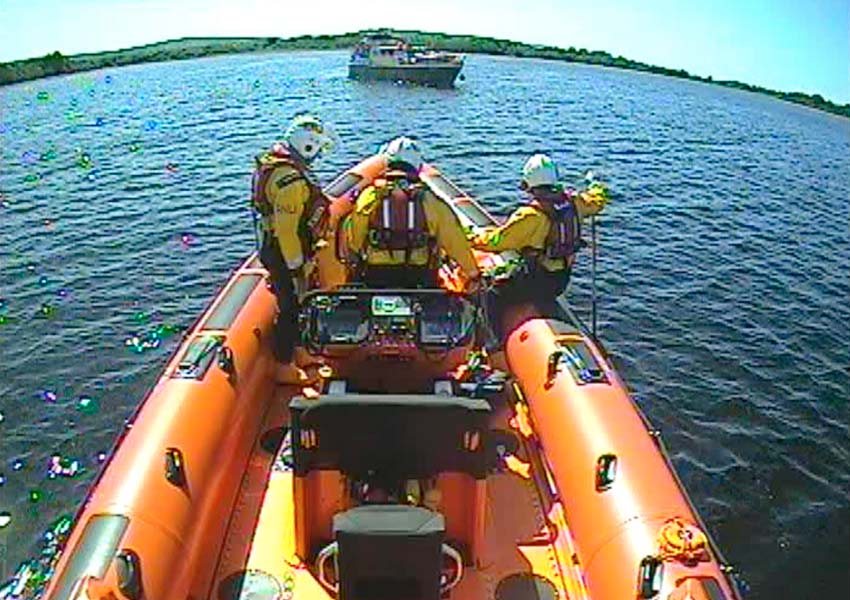 Carrybridge RNLI with the grounded vessel close to the Share Discovery Village | Photo: RNLI/Carrybridge
Carrybridge RNLI with the grounded vessel close to the Share Discovery Village | Photo: RNLI/Carrybridge
Elsewhere, Carrybridge RNLI launched its inshore lifeboat yesterday afternoon to aid a vessel with five on board that had run around around a mile north-west of the Share Discovery Village on Upper Lough Erne.
All on board were found safe and well, and wearing lifejackets. Their vessel was not taking on water, so a tow line was set up to refloat it in deeper water.
After checks for damage gave the all-clear, the vessel was allowed to continue its journey.
Lifeboat operations manager Stephen Scott added: “We would remind all users that before going afloat they should always carry a means of communication and to plan their voyage using relevant charts.
“If you see someone in trouble on the water or are in difficulties yourself the number to dial is: 999 or 112 and ask for the coastguard.”


























